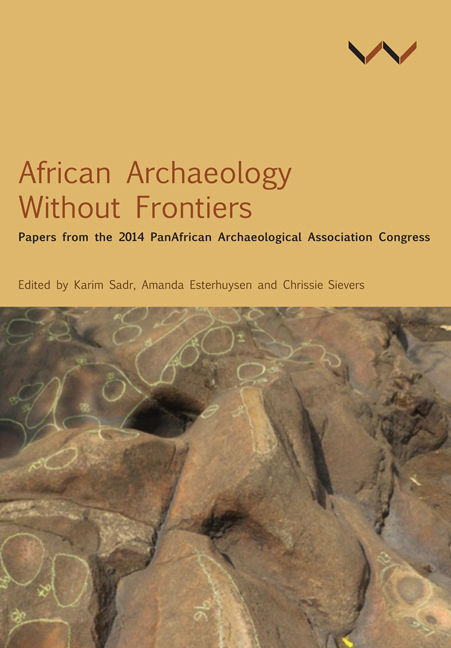 African Archaeology Without Frontiers
African Archaeology Without Frontiers Book contents
- Frontmatter
- Contents
- Acknowledgements
- List of Figures and Tables
- Introduction: An Invitation Fulfilled
- Keynote Address 1: Imagining an African Archaeology Without Frontiers
- Keynote Address 2: A Continental Vision for African Archaeology
- 1 The ‘Useable’ Archaeology of African Farming Systems
- 2 Defining Cultural Heritage among the Makonde of Tanzania
- 3 The Indigenous Roots of Swahili Culture in Pangani Bay, Tanzania
- 4 Is This an Anvil? Iron Bloom Crushing Sites in Northern Togo
- 5 L'art Rupestre au Cameroun, Nouvelles Découvertes et Contribution à L'iconographie Sous-Régionale
- 6 Archaeology and History in Iron Age Settlements in the Congo Basin
- 7 Learning from Glass Trade Beads at Thabadimasego, Botswana
- 8 Blurring Boundaries: Forager–Farmer Interactions in the Middle Limpopo Valley
- 9 Heritage Management and the World Wide Web: South African Challenges
- Contributors
- Index
4 - Is This an Anvil? Iron Bloom Crushing Sites in Northern Togo
Published online by Cambridge University Press: 15 March 2018
- Frontmatter
- Contents
- Acknowledgements
- List of Figures and Tables
- Introduction: An Invitation Fulfilled
- Keynote Address 1: Imagining an African Archaeology Without Frontiers
- Keynote Address 2: A Continental Vision for African Archaeology
- 1 The ‘Useable’ Archaeology of African Farming Systems
- 2 Defining Cultural Heritage among the Makonde of Tanzania
- 3 The Indigenous Roots of Swahili Culture in Pangani Bay, Tanzania
- 4 Is This an Anvil? Iron Bloom Crushing Sites in Northern Togo
- 5 L'art Rupestre au Cameroun, Nouvelles Découvertes et Contribution à L'iconographie Sous-Régionale
- 6 Archaeology and History in Iron Age Settlements in the Congo Basin
- 7 Learning from Glass Trade Beads at Thabadimasego, Botswana
- 8 Blurring Boundaries: Forager–Farmer Interactions in the Middle Limpopo Valley
- 9 Heritage Management and the World Wide Web: South African Challenges
- Contributors
- Index
Summary
Abstract
This study of iron bloom crushing mortar sites in the Bassar region of northern Togo has revealed several important points: 1) the heterogeneous nature of sub-Saharan African iron blooms required that they be broken up to remove slag and charcoal as part of a refining process prior to the making of iron tools, 2) this process has been documented in the Bassar region and to a lesser extent in the Sukur iron-working area of the Mandara highlands of Nigeria, but it is likely to have been present in many other areas of West Africa and beyond that have not as yet been described, 3) the larger iron bloom crushing mortar sites or outcrops, called likumanjool in the western Bassar region, were used from the Late Stone Age through the Later Iron Age for a variety of purposes, including stone axe polishing, iron bloom crushing and refining, hot forging of iron ingots and tools, and the sharpening of metal tools, but were probably not used extensively for the grinding of grain as appears to have been the case in the Mandara mountains of north-eastern Nigeria, and 4) the Bassar region study has revealed at least two stages in the location, preparation and use of stone anvils for hot forging as the Bitchabe region of Bassar moved from generalised iron working toward specialising in smithing as the intensity of iron production and trade began to grow significantly after the sixteenth century. The results of this study will hopefully encourage others to identify and study iron bloom processing sites elsewhere in sub-Saharan Africa.
The Bassar region iron-working industry
The iron-working industry of the Bassar region of northern Togo (figures 4.1 & 4.2) has been studied since the German mining engineer F. Hupfeld (1899) described it more than a century ago. In-depth cultural anthropological and archaeological studies began in the 1980s with Martinelli (1982, 1984, 1992), Goucher (1984), De Barros (1985, 1986, 1988, 2001, 2012, 2013), Dugast (1986, 1992, 2012, 2013) and Hahn (1997).).
- Type
- Chapter
- Information
- African Archaeology Without FrontiersPapers from the 2014 PanAfrican Archaeological Association Congress, pp. 60 - 84Publisher: Wits University PressPrint publication year: 2016


